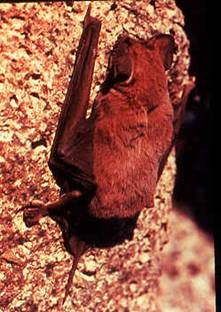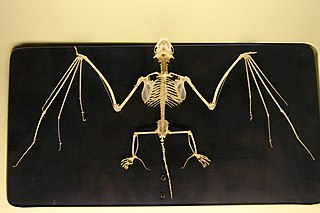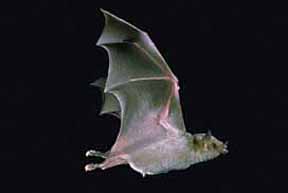
Megabats constitute the family Pteropodidae of the order Chiroptera (bats). They are also called fruit bats, Old World fruit bats, or—especially the genera Acerodon and Pteropus—flying foxes. They are the only member of the superfamily Pteropodoidea, which is one of two superfamilies in the suborder Yinpterochiroptera. Internal divisions of Pteropodidae have varied since subfamilies were first proposed in 1917. From three subfamilies in the 1917 classification, six are now recognized, along with various tribes. As of 2018, 197 species of megabat had been described.

Vespertilionidae is a family of microbats, of the order Chiroptera, flying, insect-eating mammals variously described as the common, vesper, or simple nosed bats. The vespertilionid family is the most diverse and widely distributed of bat families, specialised in many forms to occupy a range of habitats and ecological circumstances, and it is frequently observed or the subject of research. The facial features of the species are often simple, as they mainly rely on vocally emitted echolocation. The tails of the species are enclosed by the lower flight membranes between the legs. Over 300 species are distributed all over the world, on every continent except Antarctica. It owes its name to the genus Vespertilio, which takes its name from a word for bat, vespertilio, derived from the Latin term vesper meaning 'evening'; they are termed "evening bats" and were once referred to as "evening birds".

The Molossidae, or free-tailed bats, are a family of bats within the order Chiroptera. The Molossidae is the fourth-largest family of bats, containing about 110 species as of 2012. They are generally quite robust, and consist of many strong-flying forms with relatively long and narrow wings with wrinkled lips shared through their genus. Their strong flying form allows them to fly 60 miles per hour using tail winds and at altitudes over 10,000 feet. This makes them unique among bats, as they are the only bat family that withstands the elevation. They are widespread, being found on every continent except Antarctica. They are typically found in caves, abandoned mines, or tunnels.

Molossus is a genus of bats. The genus contains ten species with a New World distribution from Mexico in the north to northern Argentina at its most southerly limit. Four of these species have distributions that include various islands in the West Indies such as Puerto Rico or Trinidad.

Horseshoe bats are bats in the family Rhinolophidae. In addition to the single living genus, Rhinolophus, which has about 106 species, the extinct genus Palaeonycteris has been recognized. Horseshoe bats are closely related to the Old World leaf-nosed bats, family Hipposideridae, which have sometimes been included in Rhinolophidae. The horseshoe bats are divided into six subgenera and many species groups. The most recent common ancestor of all horseshoe bats lived 34–40 million years ago, though it is unclear where the geographic roots of the family are, and attempts to determine its biogeography have been indecisive. Their taxonomy is complex, as genetic evidence shows the likely existence of many cryptic species, as well as species recognized as distinct that may have little genetic divergence from previously recognized taxa. They are found in the Old World, mostly in tropical or subtropical areas, including Africa, Asia, Europe, and Oceania.

The New World leaf-nosed bats (Phyllostomidae) are found from southern North America to South America, specifically from the Southwest United States to northern Argentina. They are ecologically the most varied and diverse family within the order Chiroptera. Most species are insectivorous, but the phyllostomid bats include within their number true predatory species and frugivores. For example, the spectral bat, the largest bat in the Americas, eats vertebrate prey, including small, dove-sized birds. Members of this family have evolved to use food groups such as fruit, nectar, pollen, insects, frogs, other bats, and small vertebrates, and in the case of the vampire bats, even blood.

The Saussure's long-nosed bats or Mexican long-nosed bats form the genus Leptonycteris within the leaf-nosed bat family Phyllostomidae. Like all members of the family, they are native to the Americas. According to ITIS, three species are currently recognised, though varying placements of the populations into species and subspecies will be encountered. The species recognised by ITIS are:

Rousettus is a genus of Old World fruit bats or megabats, referred to as rousette bats. The genus is a member of the family Pteropodidae. The genus consists of seven species that range over most of Africa to southeast Asia, and the islands of the south Pacific. They are among the few megabats capable of echolocation, and the only genus of megabats known to use vocal echolocation.

Carollia is a genus of bats often referred to as the short-tailed fruit bats. Along with the genus Rhinophylla, Carollia makes up the subfamily Carolliinae of family Phyllostomidae, the leaf-nosed bats. Currently, nine species of Carollia are recognized, with a number having been described since 2002. Members of this genus are found throughout tropical regions of Central and South America but do not occur on Caribbean islands other than Trinidad and Tobago. Bats of the genus Carollia often are among the most abundant mammals in neotropical ecosystems and play important roles as seed dispersers, particularly of pioneer plants such as those of the genera Piper, Cecropia, Solanum, and Vismia. Carollia are primarily frugivorous; however, C. perspicillata, C. castanea, and C. subrufa are known to feed on insects.

Monophyllus, the Antillean long-tongued bats or single leaf bats, is a genus of bats in the family Phyllostomidae. They are distributed on the Antilles.

Vampyressa is a genus of bats in the family Phyllostomidae, the leaf-nosed bats. They are known commonly as the yellow-eared bats or yellow-eared vampire bats.

Vespertilio is a genus of bats in the family Vespertilionidae. The common name for this family is vesper bats, which is a better-known classification than Vespertilio. They are also known as frosted bats.

Pteralopex is a genus of large megabats in the family Pteropodidae. Species in this genus are commonly known as "monkey-faced bats". They are restricted to Solomon Islands rain forests in Melanesia, and all species are seriously threatened, being rated as either endangered or critically endangered by IUCN. Two species, P. taki and P. flanneryi, have been described since 2000.

Nyctophilus is a genus of the vespertilionids or vesper bats. They are often termed Australian big-eared bats or long-eared bats, as the length of their ears often greatly exceeds that of the head. This genus occurs in the New Guinean-Australian region.

Nyctimene is a genus of bats in the Pteropodidae family. Commonly known as tube-nosed fruit bats, they are found in the central Philippines, eastern Indonesia, Papua New Guinea and the north-east coast of Australia.
Handbook of the Mammals of the World (HMW) is a book series from the publisher Lynx Edicions. The nine volumes were published from 2009 to 2019. Each mammal family is assessed in a full text introduction with photographs and each species has a text account with a distribution map and illustrations on a plate. This is the second major project by Lynx Edicions since the release of the Handbook of the Birds of the World in 1992. The chief editors are Russell Mittermeier and Don E. Wilson in association with Conservation International, the Texas A&M University and the IUCN. Don E. Wilson is also editor of the reference work Mammal Species of the World.

Spinturnicidae is a family of mites in the order Mesostigmata. The mites are highly specialized parasites of wing or tail membrane or bats. Some species infest eyelids and eye canthi. The species of Spinturnicidae are found in bat habitats throughout the world, living all stages of life on bats.
Paranyctimene is a genus of bats in the family Pteropodidae. They are distributed in Indonesia















